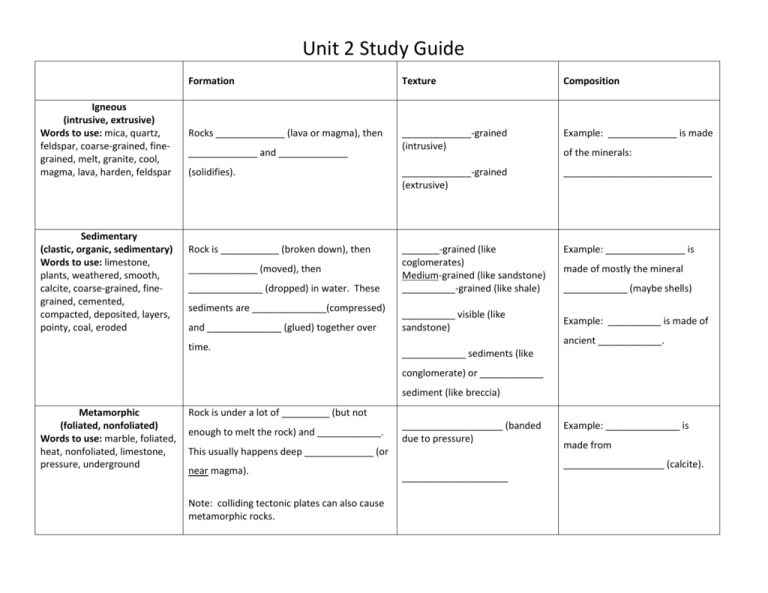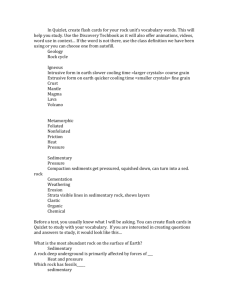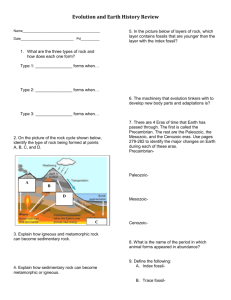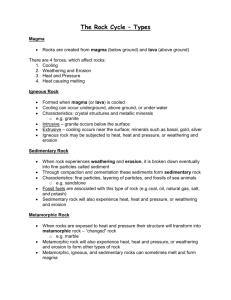File
advertisement

Unit 2 Study Guide Igneous (intrusive, extrusive) Words to use: mica, quartz, feldspar, coarse-grained, finegrained, melt, granite, cool, magma, lava, harden, feldspar Sedimentary (clastic, organic, sedimentary) Words to use: limestone, plants, weathered, smooth, calcite, coarse-grained, finegrained, cemented, compacted, deposited, layers, pointy, coal, eroded Formation Texture Composition Rocks _____________ (lava or magma), then _____________-grained (intrusive) Example: _____________ is made (solidifies). _____________-grained (extrusive) ____________________________ Rock is ___________ (broken down), then _______-grained (like coglomerates) Medium-grained (like sandstone) __________-grained (like shale) Example: _______________ is _____________ and _____________ _____________ (moved), then ______________ (dropped) in water. These sediments are ______________(compressed) and ______________ (glued) together over time. __________ visible (like sandstone) of the minerals: made of mostly the mineral ____________ (maybe shells) Example: __________ is made of ancient ____________. ____________ sediments (like conglomerate) or ____________ sediment (like breccia) Metamorphic (foliated, nonfoliated) Words to use: marble, foliated, heat, nonfoliated, limestone, pressure, underground Rock is under a lot of _________ (but not enough to melt the rock) and ____________. ___________________ (banded due to pressure) This usually happens deep _____________ (or near magma). Note: colliding tectonic plates can also cause metamorphic rocks. Example: ______________ is made from ___________________ (calcite). ____________________ Rocks _____________ (molten rock cools/hardens) ________ (magma) >larger grains< Ex: _________ _________ (lava) >fine-grained< Ex: _________ _________________ (weather/erosion/deposition, THEN compaction and cementation ______________ (heat and extreme pressure) _________ ________ ________ ________ _________ (small pieces (once living) (evaporation) stuck together) (banded) (not banded) Ex: _________ Ex: _________ Ex: _________ Example to use: sandstone, marble, granite, gneiss, fossil limestone, basalt, rock salt Ex: _________ Ex: _________ Rock Riddles Riddle 1: Use the poetic information provided below to identify the igneous rock. Some lava may be hotter, But this one floats on water. And when you need to sine or grind, This is the rock to keep in mind. Here are two more hints: It has ice in it, but the ice won’t melt. Rodents are part of its name. Riddle 2: The earth produces a giant mass of intrusive igneous rock. What is it called? To find out, supply the missing letters in the clues below. When you put the missing letters together, you’ll know what the mass is called. 1. The opposite of good: _ _ d 2. Big Bang _ _ eory. 3. Ring-shaped island of coral: at_ _ l. 4. Earth’s outer shell: l_ _ _ osphere _________________ Riddle 3: Metamorphic rocks form only at great depth or at high temperature. Sedimentary rock and igneous rock can be transformed into metamorphic rock. For example, shale turns into slate and sandstone turns into quartzite. What sedimentary rock transforms into marble? If you put the following clues together, you’ll have the answer. Challenge: come up with your own clues. Create a puzzle to show the transformation of quartzite or slate. Riddle 4: Use the five clues below to help you identify the mystery metamorphic rock. Clues 1. Most show a distinct banded structure 2. Usually light colored 3. Commonest metamorphic rock 4. A course-textured rock 5. It looks something like this: The mystery metamorphic rock is _ _ _ _ _ _ .








